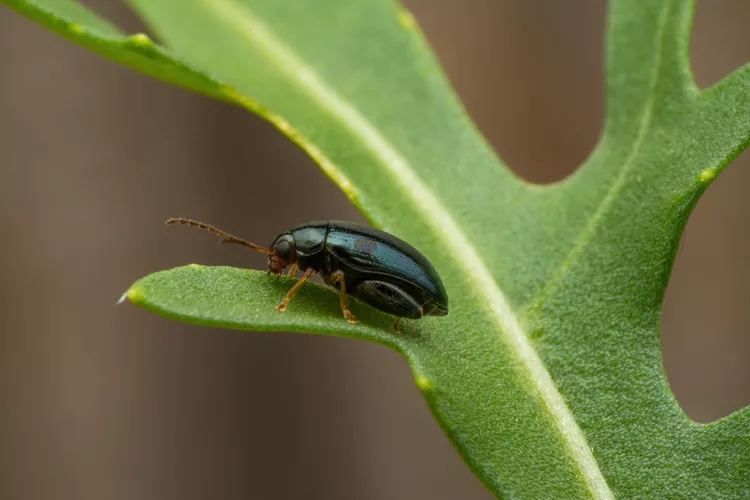Flea beetles are troublesome insects that can cause a lot of damage to vegetable crops and ruin the appearance of leafy greens. If you’ve noticed tiny black bugs on your plants or your plant leaves are covered in small “shot holes,” you may be dealing with flea beetles. In this guide, you’ll find everything you need to organically get rid of flea beetle infestations and keep these pests out of your garden for good.
What are flea beetles?
Flea beetles are named for their miniscule size and curious patterns of movement. When disturbed, these bugs use their long back legs to rapidly jump away, similar to their namesake insect. Flea beetles rarely measure over 1/8 inch long, and it can be difficult to spot them because they move so quickly.
There are several different species of flea beetles and they come in a variety of different colors. Most commonly, flea beetles range in color from tan to black. Some species sport brighter tones and a few even have striped or spotted shells.
Adult flea beetles overwinter in garden debris and emerge in early spring when temperature reach about 50ºF. After breeding, flea beetles lay their eggs around the base of young plants. Young
flea beetles often feed on plant roots, while adults will riddle plant leaves with holes.
What do flea beetles eat?
Different types of flea beetles feed on different plants. Some flea beetle species are generalists and will target an assortment of plants; however, most species are specialists and only feed on a single type of plant.
In the garden, plants in the brassica family, like broccoli, cauliflower, and kale, are particularly susceptible to flea beetle damage. Flea beetles also love munching on the leaves of nightshade plants, such as tomatoes, peppers, and eggplants. The pests can be found on other food crops including squash, corn, and lettuce. Certain weeds may attract flea beetles, too, which is a good reason to stay on top of weeding.
What does flea beetle damage look like?
Because flea beetles are so small and fast-moving, it can be difficult to notice the bugs themselves in your garden. It’s usually a lot easier to tell that you're dealing with a flea beetle infestation by the damage they leave behind.
Flea beetle larvae feed on plant roots and usually don’t cause a lot of damage, although they may stunt seedling growth. Adult flea beetles, on the other hand, can be quite destructive. As they nibble on plants, they cause a mottled appearance to leaf surfaces and riddle leaves with tiny pits and holes.
Seedlings can be particularly vulnerable to flea beetle damage because the insects are most active in spring and they are drawn to tender, new leaves. Full-sized plants can normally withstand flea beetle damage; however, leafy greens won’t look as nice. The real problem with flea beetles is that they can transmit several common plant diseases, including blights and wilts, which can devastate
crops.
How to Get Rid of Flea Beetles
Once a flea beetle infestation is established in your garden, it’s important to act quickly in order to limit the damage. One of the easiest ways to address small infestations of flea beetles is to spray your plants with an organic insecticidal soap or neem oil spray. These sprays should be applied in the evening after the sun sets to avoid leaf burn. If you’d like to make your own insecticidal soap spray, simply mix a few drops of Castile soap into a quart of water and add a tablespoon or two of neem oil.
Kaolin clay is another useful organic treatment option for flea beetles and other plant pests. To apply, blend kaolin clay powder with water according to label directions. Then spray the mixture over any infested plants on a dry day. Once in place, kaolin clay makes it difficult for pests to feed on plants and it prevents egg laying too.
Tips for Preventing Flea Beetles
The keys to keeping flea beetles and other garden pests under control are practicing good garden maintenance and making smart planting choices.
- If your garden suffered from a flea beetle invasion in previous years, be sure to clean up any infected plant debris before planting again. Also consider tilling your soil if the infestation was very bad.
- Set up floating row covers early in the season to protect your garden from flea beetles and other insects.
- Delay planting seeds and seedlings for a few weeks in spring. This can starve out flea beetles and keep your new plants safe.
- Companion planting is an easy, all-natural way to deter flea beetles. For example, these insects avoid aromatic plants such as catnip and green onions, and will often also avoid any nearby plants.
- Grow flowering plants to attract beneficial insects that will naturally feed on flea beetles. Good options include planting dill and sweet alyssum near the veggies you want to protect.
- Sow a trap crop like radishes to lure flea beetles away from more valuable produce and shield your leafy greens from damage.




















